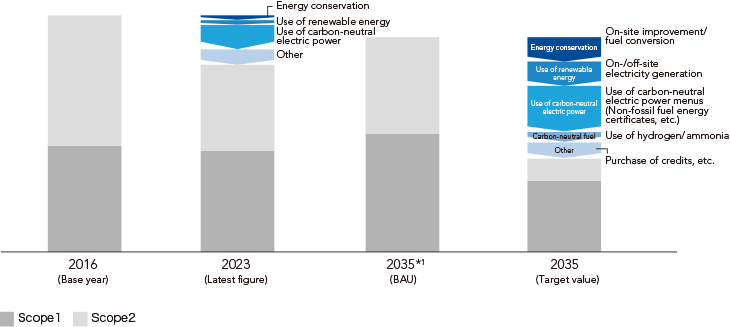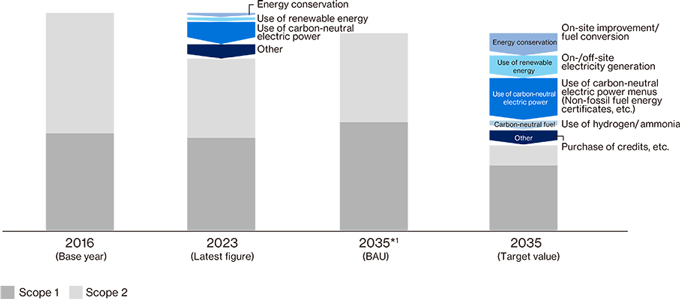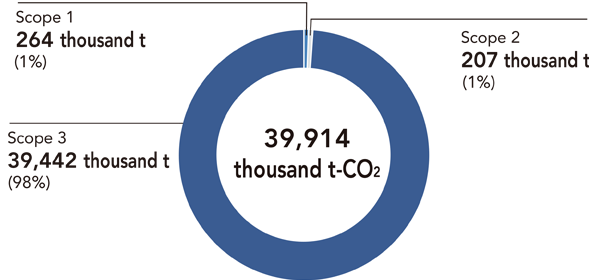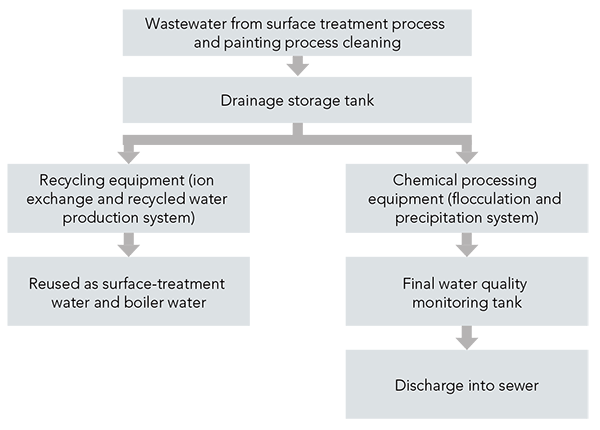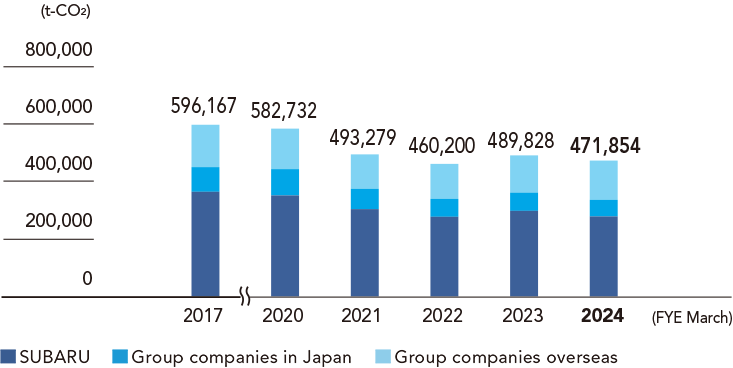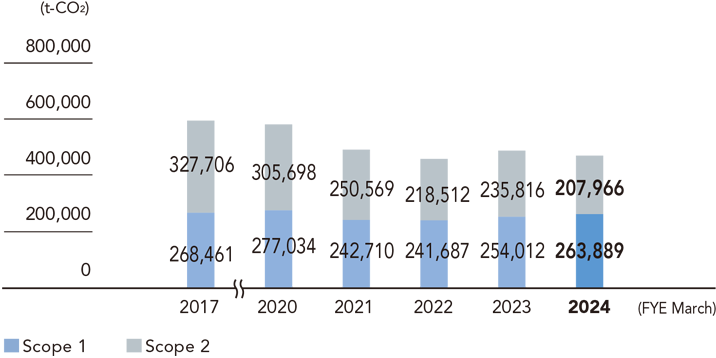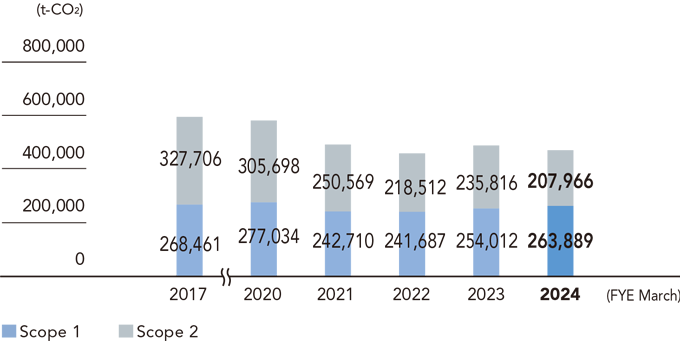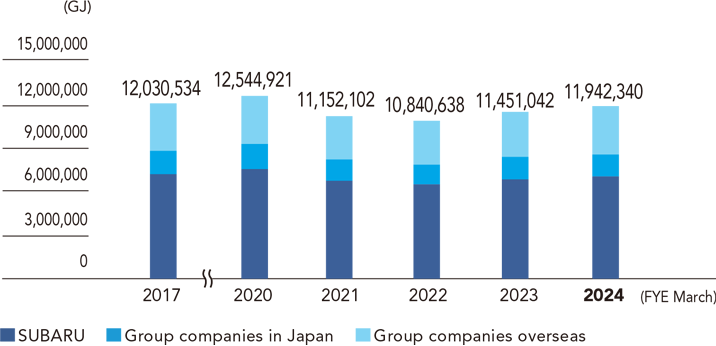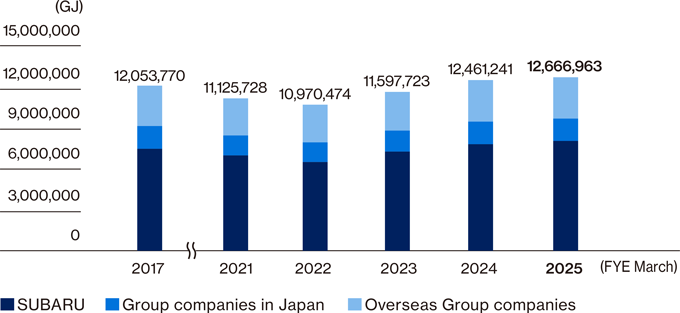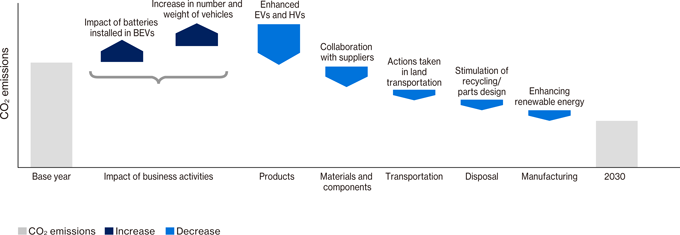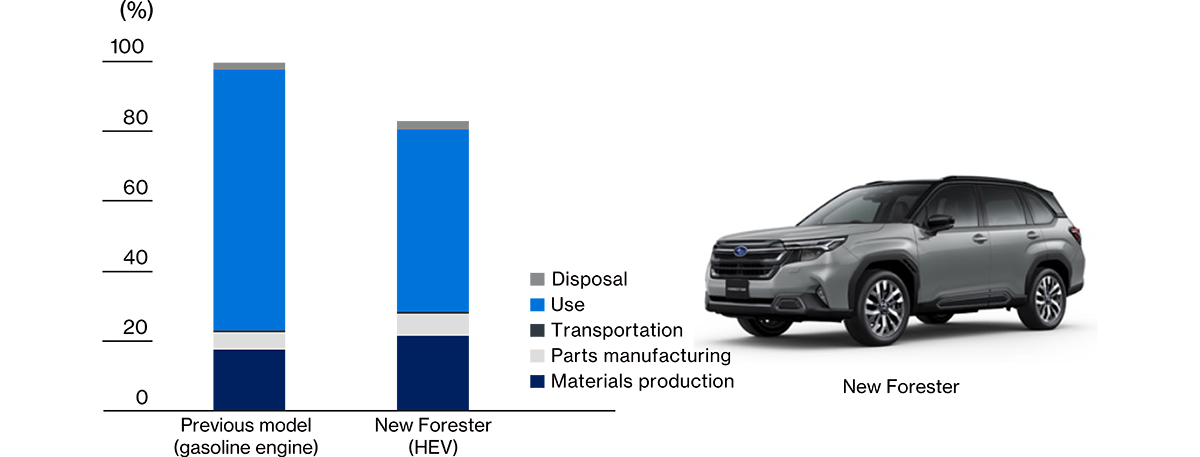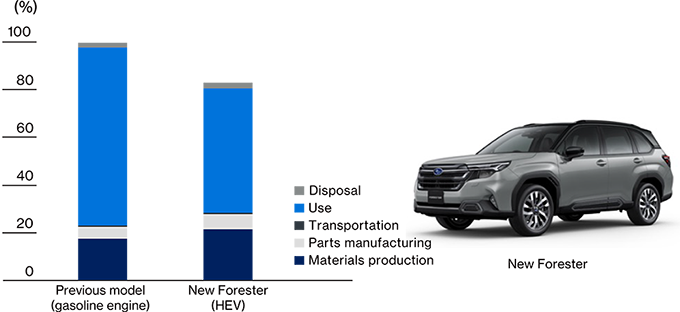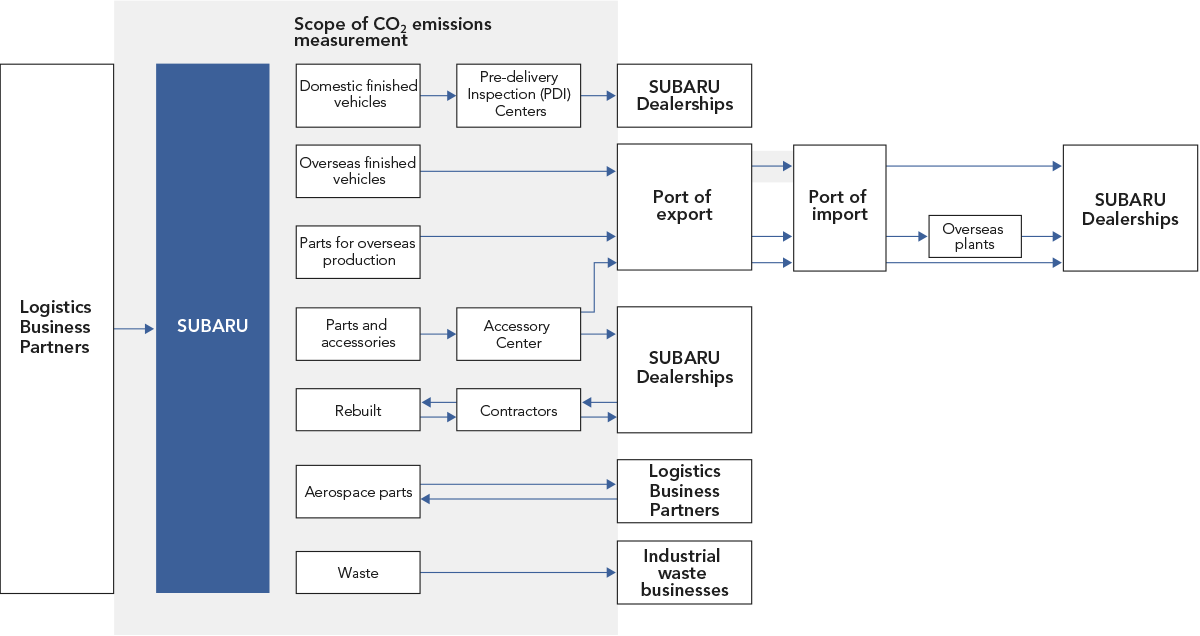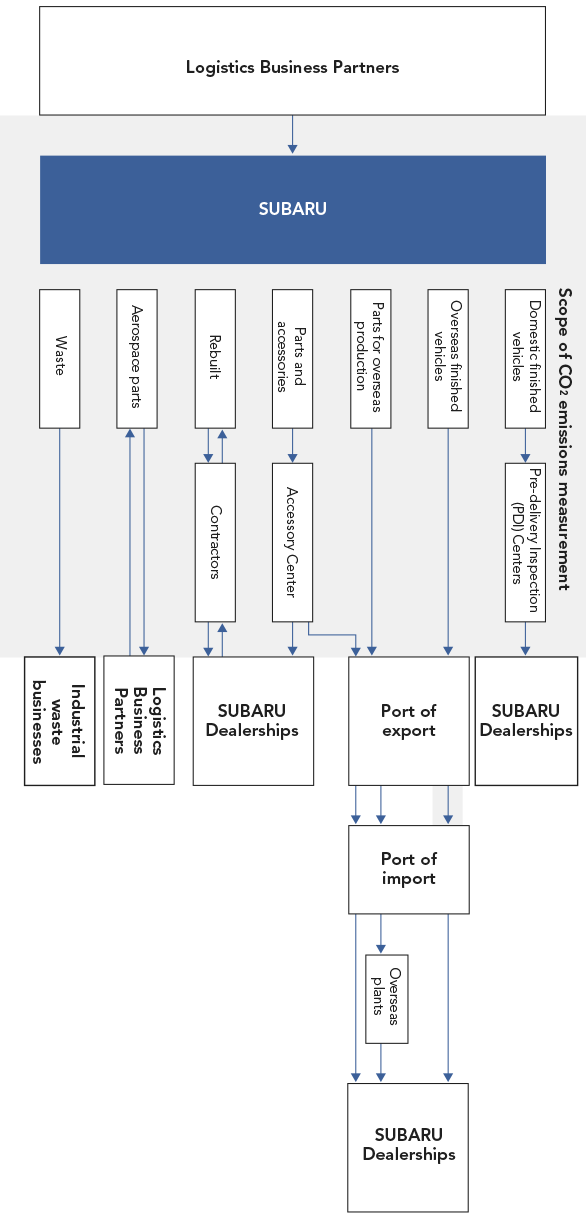Mitigating Climate Change
Our Approach
SUBARU recognizes that climate change is a pressing global issue. About 80% of the SUBARU Group’s CO2 emissions (Scope 1, 2, and 3) are from the use of sold products. SUBARU Group’s efforts to respond to electrification by strengthening its BEV business and HEV products, as well as its use of carbon neutral fuels, will lead to a reduction in CO2 emissions during product use, ultimately contributing to the mitigation of climate change. Although CO2 emissions directly attributable to SUBARU Group business activities (Scope 1 and 2) account for only a small percentage of total CO2 emissions, we believe that taking the initiative in reducing direct CO2 emissions will lead to the enhancement of activities throughout the entire value chain through an all-SUBARU approach.
Based on this concept and toward its target of achieving carbon neutrality by 2050, SUBARU has set long-term goals and medium-term goals as its intermediate milestones, and will reduce CO2 emissions from its products, factories, and offices to help decarbonize society, working to mitigate climate change.
Mitigating Climate Change: Roadmap
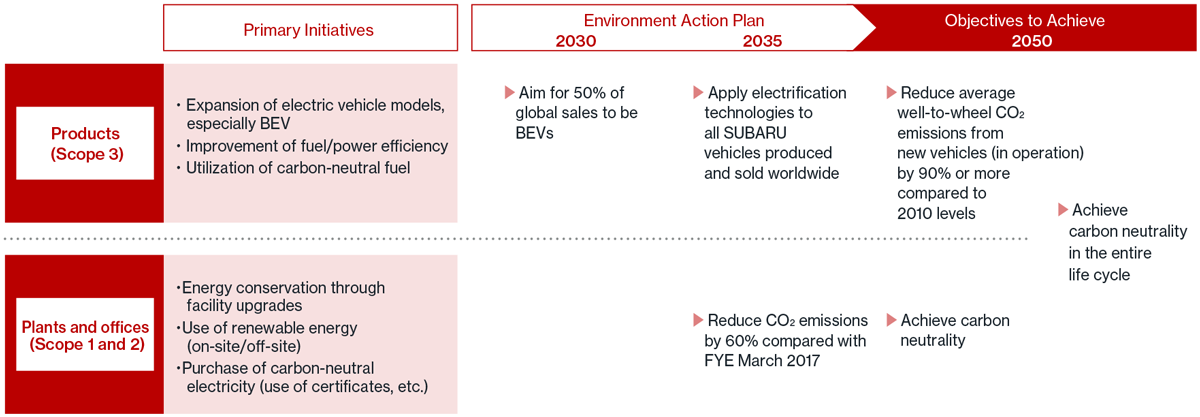
Management System
SUBARU has established the Environment Committee, which discusses measures (e.g., targets) from broad and medium- to long-term perspectives that accommodate future environmental standards required by society, and evaluates the progress of related implementations and achievements. The Environment Committee is chaired by the Executive Officer in charge of the Sustainability Division appointed by the Board of Directors. Details of discussions by the Environment Committee are reported to the Sustainability Committee. Important matters are also brought to the attention of and reported to the Board of Directors, which oversees the Sustainability Committee.
In 2025, the CN Promotion Meeting was dissolved. Now, efforts to decarbonize the entire value chain, including products, factories, offices, procurement, transportation, and disposal, will be promoted by each subcommittee or other relevant organization, with overall activities overseen by the Environment Committee.
Governance Structure for Climate Change
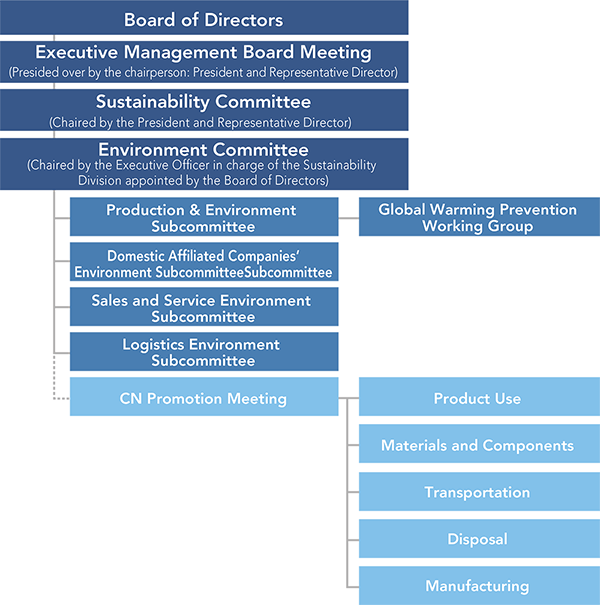
Risks and Opportunities Identified
SUBARU defines and identifies risks and opportunities associated with climate change to achieve sustainable business activities.
We have identified a number of risks associated with climate change. Initiatives to address climate change may be inadequate or abnormal weather may cause delays in procurement, production, and distribution. In addition, transition risks and physical risks may have impacts and outcomes that are currently extremely difficult to predict. Increased R&D expenses, lost sales opportunities due to reduced customer satisfaction and brand image, and delays in procurement, production, and distribution due to abnormal weather are among the potential impacts of these risks. These risks could have a material impact on the operating results and financial position of the SUBARU Group.
On the other hand, effective initiatives to address climate change could lead to opportunities to create new markets and employment and also use capital and energy more efficiently.
Main Risks Identified
Business Management in General
Reputational risk
(1) If SUBARU fails to implement adequate initiatives to achieve low-carbon/zero-carbon outcomes, its brand value could be harmed, which could affect the Company’s sales and recruiting ability. Capital costs could also rise, due to increased difficulty in obtaining financing from medium- and long-term investors.
Regulatory risk
(2) There is an argument that nationally determined contributions (NDCs) need to be expanded to be able to achieve the Paris Agreement’s “well below 2°C” target, and thus countries may revise their NDCs to set more stringent targets. Such revisions could have a significant impact on SUBARU’s business activities.
Acute physical risk
(3) As an impact of climate change, extreme torrential rain will frequently cause floods in various locations, which could pose risks of SUBARU’s operations being affected by disrupted supply of raw materials and submerged factories.
Products
Regulatory risk
(1) If SUBARU fails to meet fuel economy regulations imposed in Japan, the U.S., Europe, and China, the Company could incur additional costs or losses related to negative incentives, such as fines or non-penal fines for legal violation, and credit purchase for unmet standards. Also, some of our products could fail to satisfy certain fuel economy standards, resulting in restrained sales opportunities.
Market risk
(2) At present, it is difficult to predict technological progress and price optimization for electrification, which will likely cause a substantial gap with the real state of market needs. In such a situation, SUBARU could incur unnecessary and excessive R&D costs while facing a decline in customer satisfaction, resulting in unexpected losses and reduced sales opportunities as well as hampered advancement of the Company’s electrification efforts.
(3) SUBARU views electrification as a steady medium- to long-term trend, and also anticipates the possibility of its swift and sweeping penetration of the market at some stage. SUBARU could be unprepared for such prospect in terms of technology and timely product lineups, and thus suffer from a resultant loss of product sales opportunities.
Technology risk
(4) To promote electrification, it is crucial to ensure profitability for the entire product cycle ranging from procurement and use to disposal. Thus, it is essential to involve SUBARU’s upstream and downstream partners in exerting efforts toward this end. Failure to do this could render the Company unable to meet the profitability goal for the entire product life cycle.
Chronic physical risk
(5) There is a possibility that SUBARU might suffer from shortages of natural resources used for tires and metal resources, such as materials for automotive batteries, for electrification technologies.
Production Phase
Regulatory risk
(1) If SUBARU continues to use energy derived from fossil fuels, it could incur rising costs, due not only to geopolitical factors associated with petroleum and the like, but also to carbon taxes, emission quotas, and other government policies and regulations.
Technology risk
(2) If use of renewable energy does not grow as expected, SUBARU could face slower progress in achieving its Scope 1 and 2 emissions reduction goals
Main Opportunities Identified
Market opportunity
(1) If SUBARU advances its efforts to make products more environmentally friendly as planned and global climate change mitigation/adaptation efforts progress adequately, the Company will be able to maintain its key markets while at the same time potentially expanding in markets receptive to its offer of “Enjoyment and Peace of Mind.”
(2) Through contributing to addressing climate change issues, SUBARU could increase its brand value, thereby enhancing its sales and recruiting ability. This could make it easier for the Company to obtain financing from investors, thereby lowering capital costs.
Energy-related opportunity
(3) Regarding energy use during the production phase, by transitioning to renewable energy while at the same time giving due consideration to cost-effectiveness, SUBARU could overcome the risk of being exposed to price fluctuations involved in energy derived from fossil fuels, thereby preventing future cost increases.
- Note:
- The risks and opportunities described above are based on past facts and currently available information, and may change significantly due to such factors as future economic trends and the business environment facing SUBARU. The opportunities described represent those for SUBARU’s products to contribute to climate change adaptation and do not anticipate climate change-related deterioration
Examples of scenarios and their risks/measures
The SUBARU Group explores climate change-related countermeasures in consideration of a variety of scenarios, including its own scenario assuming carbon neutrality by 2050 (equivalent to the 1.5°C scenario), based on policy trends in various countries relating to the regulation of fuel economy and other areas and information published by the International Energy Agency and other organizations. This exploration also incorporates risks and opportunities recognized with respect to sustainable business activities.
For example, we are working to formulate measures for the transition to electrification and responding to water-related disasters, taking into consideration scenarios such as one in which the percentage of EVs sold in the market increases significantly, as well as one in which the market penetration of EVs increases modestly, and one in which measures to address climate change do not progress and natural disasters become more severe.
| Scenario | Example scenario risks of particular importance | Measures considering risks and opportunities | |
|---|---|---|---|
| Penetration of electrification | Products | Risk of limited product sales opportunities due to failure to meet certain fuel economy standards | Building a production system that can dynamically adapt the production ratio between BEVs, hybrids, and ICE vehicles, keeping a close eye on environmental regulations and market trends |
| Risk of market need diverging from electrification technology | |||
| Increasing severity of natural disasters | Business management | Risk of operations being affected by disrupted supply of raw materials and submerged factories as a result of frequent flooding in various locations from extreme torrential rain |
|
Strategy
As part of our medium- to long-term efforts to achieve carbon neutrality, we are looking to the BEV business to become a mainstay of our operations in the future. On the other hand, with growth in the BEV market currently in a slowdown, we expect that reaching a 50% BEV sales ratio may be delayed past the 2030 target. This is given various external factors such as the spread of charging stations, environmental regulations in various countries, and revisions of subsidies and tax incentives for BEVs. In addition to this situation, we are currently in the process of refining our efforts toward 2030 in light of U.S. policy trends, and we will make another announcement on this topic.
At this stage, it is difficult to foresee the future direction of electrification. Therefore, while keeping a close eye on the trends in regulations and the market, SUBARU is taking various actions based on the recognition that it is extremely important to ensure flexibility and expandability, using this concept to adapt to such changes flexibly and to expand at once when the direction of the shift becomes clear.
Flexibility in Product Development in the BEV Early Transition Stage
We have explored various options for the development of BEVs, including in-house development and alliance cooperation, but for the four BEVs planned for our lineup by the end of 2026, we are developing them jointly with Toyota Motor Corporation. In this development, we are working together under the slogan, “to make ever-better cars,” by bringing together our respective strengths in technology and expertise, with engineers from both companies engaging in mutual learning and collaboration. Joint development has led to the accumulation of technology and expertise in preparation for the era when BEVs are mainstream, as well as to curbing development costs for both companies.
The first jointly developed model, the Solterra, was unveiled in November 2021, and in April 2025, we unveiled the second model as the new Trailseeker, which deftly combines the driving performance of a BEV with the practicality of a crossover utility vehicle. The Trailseeker is scheduled to be launched to the U.S. market in 2026 or thereafter. In July 2025, the third model, Uncharted, was unveiled, combining the driving performance of a BEV with highly practical ease of use and handling, despite its compact size. This model is also planned to be launched to the U.S. market in 2026 or thereafter.
In this BEV early transition stage, SUBARU also believes that HEVs will be of extreme importance, and we have been developing the Next-generation e-BOXER, SUBARU’s unique HEV based on the TOYOTA Hybrid System. This has featured in the mainstay Foresters and Crosstreks from their 2024 model year, launched to great acclaim in the Japanese and North American markets. Among many choices, the final decision is, ultimately, made by the customer. To provide more options to our customers, we believe it is important to provide flexibility in our products by offering not only BEVs but also a wide range of ICE-based products.
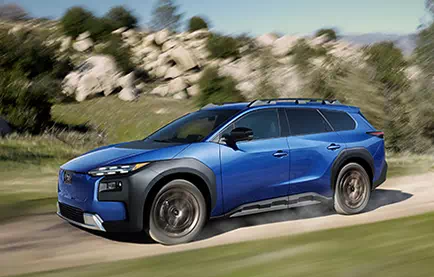
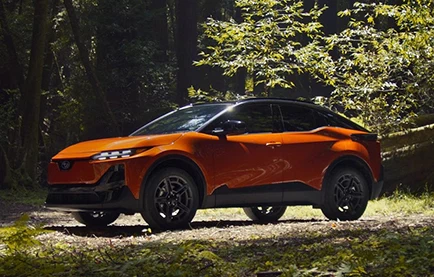
Flexibility in Production System in the BEV Early Transition Stage
Through mutual production and supply of BEV models jointly developed alongside Toyota Motor Corporation, we will ensure flexibility in our production areas, and mitigate risks together in these times when it is difficult to foresee the future. In addition to the Solterra that has already been launched in the market, BEVs produced at Toyota Motor Corporation’s U.S. plant will also be supplied to SUBARU. Furthermore, around 2025, BEVs produced at the Yajima Plant within the Gunma Plant (SUBARU model: Trailseeker) will be supplied to Toyota Motor Corporation. SUBARU plans to practice mixed production that includes ICE products, through which we will adjust our produced models flexibly in response to demand trends, allowing us to maintain operations.
In addition, in fall 2024 the Kitamoto Plant, which was previously the production and sales base for the Industrial Products Business, was renovated and the production of transaxles, a core component of the Next-generation e-BOXER, was launched there. The Next-generation e-BOXER was first installed in vehicles produced at our plants in Japan, and is to be installed in vehicles produced by Subaru of Indiana Automotive, Inc. starting in 2026. In response to the recent increase in demand for HEVs, we will increase the production capacity of the Next-generation e-BOXER core unit at the Kitamoto Plant from 180,000 units to just under 300,000 units by 2027. This approach is aimed at maximally utilizing production capacity in Japan and the U.S. by ensuring a production system that can flexibly respond to demand fluctuations and environmental regulation trends, and is in consideration of plans to supply BEVs produced at the Yajima Plant to Toyota Motor Corporation.
Aim to Halve Development Days, Production Processes, and Number of Parts while Implementing Planned CO2 Emission Reduction Measures in Plants and Offices
SUBARU will strive to achieve world-leading Monozukuri by cutting the development lead time in half, the configuration and number of parts in half, and the production process in half. In our current operations, each functional domain, such as product planning, design, and production, waits for the previous process to complete its work, and then passes the work on to the next process like a relay. Through our “Monozukuri Innovation” initiatives, we will make the process agile, which will lead to a 50% reduction in Monozukuri time.
At the same time, by continuously advancing these initiatives, we will reduce the process and lead time for product development and production and strengthen our ability to respond to domains experiencing non-linear transformation in this age of uncertainty.
SUBARU aims to halve development lead times, the production process, and the configuration and number of parts, while also aiming to reduce CO2 emissions from plants and offices (Scope 1 and 2 emissions) by 60% in 2035 versus FYE March 2017 levels on a total volume basis. SUBARU will take actions toward energy self-sufficiency and efficiency and therefore accelerate the reduction of CO2 emissions through streamlining in a dual approach for both the manufacturing process and product structure.
The SUBARU Group will systematically implement measures to reduce Scope 1 and Scope 2 emissions by 2035, including energy-saving measures, the introduction of carbon-neutral fuel such as hydrogen and ammonia, and the use of in-house and purchased carbon-neutral power generation, with the aim of achieving its targets.
Illustration of Scope 1 and 2 Emission Reduction Measures and Impact up to 2035
- *1
- Assuming the electricity emission coefficient in Japan decreases to 0.25 t-CO2 per thousand kWh
Risk Management
The automotive industry is ushering in a major transformation, which only occurs once in a hundred years. The SUBARU Group, which operates businesses globally, is aiming to enhance the resilience of its management infrastructure by ensuring the sustainability of its businesses by quickly tackling changes in world affairs. At the same time, the Group must boost its measures to minimize its human, social, and economic losses. Amid this environment, it is essential to strategically conduct risk management throughout the Group to conduct business activities. We therefore believe it is important to create a SUBARU Group that has an infrastructure that is resilient to risk to enhance our corporate value. As the environment surrounding the SUBARU Group continues to experience disruptive and non-linear changes at an unprecedented pace, we are working to further strengthen our risk management, including the use of a new Risk Map formulated through management-level discussions that take into account external changes and the current environment, in addition to the important risks of each division, in order to more reliably achieve the New Management Policies.
To address climate change-related transition risks in policy and regulation, technology, markets, and other items, dedicated departments at SUBARU gather information from a wide range of sources and work to identify uncertain climate change-related risks from future projections. These transition risks are proposed and discussed during the Executive Meeting, and particularly significant matters are subject to deliberation within the Board of Directors before decisions are made.
The physical risks associated with climate change include flooding and other natural disasters. The Risk Management and Compliance Office plays a pivotal role in establishing regulations in response to these operational risks as part of the BCP system. During emergencies, the office centrally grasps Group-wide information, establishing a system to manage Group-wide response.
Medium- to Long-term Goals (Long-term Vision and Milestones)
In order to contribute to a decarbonized society, SUBARU has set long-term goals (long-term vision) for 2050 and medium-term goals (milestones) regarding products (Scope 3) and plants and offices (Scope 1 and 2). These medium-term goals are reviewed as necessary according to the business environment, which is experiencing rapid, disruptive changes. In 2023, the medium-term goal for plants and offices (Scope 1 and 2) has been set as reducing CO2 emissions by 60% in FYE March 2036 versus FYE March 2017. The medium-term goal for products (Scope 3) has been re-established as aiming to make BEVs 50% of all automobiles sold in 2030.
SUBARU is investigating compliance with relevant policies including the fuel efficiency regulations of the countries it serves. We formulate our own scenarios and plans for achieving our medium- to long-term goals based on policy trends and scenario-specific information published by the International Energy Agency and others.
| Category | Target Year | Goal |
|---|---|---|
| Products (Scope 3) |
2050 | Reduce average well-to-wheel CO2 emissions from new vehicles (in operation) by 90% or more compared to 2010 levels |
| Early 2030s | Apply electrification technologies to all SUBARU vehicles produced and sold worldwide | |
| 2030 | Aim for 50% of global sales to be BEVs | |
| Plants and offices (Scope 1 and 2) | FYE March 2051 | Achieve carbon neutrality |
| FYE March 2036 | Reduce CO2 emissions by 60% compared with FYE March 2017 (total volume basis) |
Initiatives
For FYE March 2025, SUBARU has reported a total of 38,067 thousand t-CO2 of supply chain greenhouse gas emissions (Scope 1, 2, and 3). Out of the total amount, 98.5% is related to Scope 3, the majority of which stems from the use of sold products. Although the Group’s direct CO2 emissions (Scope 1 and 2) constitute only a marginal portion of the total (including Scope 3), we are making proactive efforts to diminish direct emissions, which we believe will encourage the entire SUBARU value chain to work as a team and in greater earnest.
As for FYE March 2025 results regarding products, EVs accounted for 7.9% of global sales, and BEVs accounted for 1.9%. We will grow our earnings base in the BEV era by strengthening our supply capacity for EVs, including the start of in-house BEV production in the mid-2020s in conjunction with the reorganization of our domestic production system, the launch of the Next-generation e-BOXER, and the addition of dedicated BEV production lines in the late 2020s. As we do this, we will work to ensure a high level of financial soundness, taking actions in a sustainable structure.
In addition, the FYE March 2025 results for plants and offices showed Scope 1 and 2 emissions of 569,337 tons based on market standards, representing a 17% reduction compared to FYE March 2017 (566,234 tons based on location standards). Furthermore, renewable energy in FYE March 2025 accounted for 10.0% of the energy consumption of the entire SUBARU Group and 22.8% of its total electricity consumption. All of the electricity purchased at the six SUBARU locations of Gunma Main Plant, Utsunomiya South Plant and 2nd South Plant, the Handa West Plant (including Yusoki Kogyo K.K.), the Isesaki Plant, and the Ebisu Subaru Building, and at the two Group companies in Japan of Subaru Finance Co.,Ltd. and Kiryu Kogyo Co., Ltd. is carbon-neutral electric power.
- Scope 1: Direct emissions of greenhouse gases from a company’s own facilities
- Scope 2: Indirect emissions of greenhouse gases from the use of purchased or acquired electricity, heat, and/or steam supplied by another company
- Scope 3: All indirect emissions other than Scope 1 and 2 emissions, including those arising from the procurement of raw materials, transport, product use, and the disposal process, as well as arising from employee commuting, business travel, etc.
Results and future plan of percentage of EVs sold (retail sales basis)
Scope 1 and 2 emissions (by organization)
Scope 1 and 2 emissions (by scope)
Scope
- SUBARU:
- SUBARU CORPORATION
Group companies in Japan:
39 domestic consolidated subsidiaries (including 23 SUBARU domestic dealerships that are consolidated subsidiaries)
Overseas Group companies:
Subaru of Indiana Automotive, Inc., Subaru of America, Inc., Subaru Canada, Inc., North American Subaru, Inc.
The scope of data for domestic Group companies is that for consolidated subsidiaries, and the confirmation for Scope 1 and 2 emissions is 99% (based on proportion of workforce)
Scope 1 and 2 emission calculation method
Scope 1 emissions=Fuel consumption×Unit calorific value×Carbon emission coefficient×44/12
Sources of calorific values and carbon emission coefficients Japan: Ministry of the Environment, “Greenhouse Gas Emissions Calculation and Reporting Manual” and “List of Emission Coefficients by Gas Utility"; U.S and Canada.: Values published by the U.S. Environmental Protection Agency
Scope 2 emissions=Electricity use×CO2 emissions per unit of electricity use
Sources of CO2 emissions per unit of electricity use
Market-based Japan: Ministry of the Environment, “List of Emission Coefficients by Electric Utility"; U.S. (Subaru of Indiana Automotive, Inc.): Values published by the Edison Electric Institute; U.S. (three companies excluding Subaru of Indiana Automotive, Inc.): Values published by the U.S. Environmental Protection Agency; Canada: Values published by the Canadian government
Location-based Japan: Replacement values from the Ministry of the Environment, “Greenhouse Gas Emissions Calculation and Reporting Manual"; U.S.: Values published by the U.S. Environmental Protection Agency; Canada: Values published by the Canadian government
In addition, errors were found in the aggregated data, and corrections were made for previous fiscal years
Energy use (by organization)
Scope
- SUBARU:
- SUBARU CORPORATION
Group companies in Japan:
39 domestic consolidated subsidiaries (including 23 SUBARU domestic dealerships that are consolidated subsidiaries)
Overseas Group companies:
Subaru of Indiana Automotive, Inc., Subaru of America, Inc., Subaru Canada, Inc., North American Subaru, Inc.
SUBARU calculates energy consumption (GJ) based on the Act on the Rational Use of Energy
In addition, errors were found in the aggregated data, and corrections were made for previous fiscal years
CO2 Emissions (Scope 3)
| Category | Greenhouse Gas Emissions (t-CO2) | |||||
|---|---|---|---|---|---|---|
| FYE March 2021 | FYE March 2022 | FYE March 2023 | FYE March 2024 | FYE March 2025 | ||
| 1 | Purchased goods and services | 5,136,697 | 4,339,656 | 5,018,874 | 5,861,321 | 5,902,914 |
| 2 | Capital goods | 282,713 | 260,567 | 402,915 | 549,384 | 577,752 |
| 3 | Fuel- and energy-related activities not included in Scope 1 or Scope 2 | 91,851 | 89,627 | 95,352 | 54,958 | 55,697 |
| 4 | Transport and delivery (upstream) | 601,167 | 506,604 | 426,929 | 500,914 | 516,878 |
| 5 | Waste generated in operations | 26,446 | 24,888 | 28,733 | 8,608 | 26,081 |
| 6 | Business travel | 4,689 | 4,798 | 4,878 | 4,900 | 4,923 |
| 7 | Employee commuting | 14,245 | 14,576 | 14,818 | 14,885 | 14,954 |
| 8 | Leased assets (upstream) | N/A | N/A | N/A | N/A | N/A |
| 9 | Transportation, distribution, and sales (downstream) | 3,893 | 4,750 | 4,043 | 3,521 | 9,295 |
| 10 | Processing of sold products | N/A | N/A | N/A | N/A | N/A |
| 11 | Use of sold products | 27,442,228 | 23,102,609 | 27,453,385 | 31,859,417 | 29,799,828 |
| 12 | End-of-life treatment of sold products | 509,850 | 437,960 | 512,716 | 602,519 | 582,477 |
| 13 | Leased assets (downstream) | 7,355 | 7,487 | 7,376 | 6,259 | 6,852 |
| 14 | Franchises | N/A | N/A | N/A | N/A | N/A |
| 15 | Investments | N/A | N/A | N/A | N/A | N/A |
| Total | 34,121,134 | 28,793,522 | 33,970,018 | 39,466,686 | 37,497,651 | |
| Category | Calculation Method | |
|---|---|---|
| 1 | Purchased goods and services | CO2 emissions per unit in the manufacture of materials and components × Annual sales volume - Scope 1 and 2 emissions of Group companies responsible for parts manufacturing |
| 2 | Capital goods | SUBARU Group capital investment × CO2 emissions per unit of capital investment |
| 3 | Fuel- and energy-related activities not included in Scope 1 or Scope 2 | Σ (Energy use for each type × CO2 emissions intensity for each energy type) |
| 4 | Transport and delivery (upstream) | Domestic transportation in Japan: Calculated in accordance with the calculation standards as a specified consignor under the Act on Rationalization of Energy Use and Shift to Non-fossil Energy |
| Marine transportation at the time of export: Σ (Number of units exported to each country × Weight of product × Transportation distance) × CO2 emissions intensity of marine transportation | ||
| 5 | Waste generated in operations | Σ (Emissions of each kind of waste × CO2 emissions intensity of each kind of waste) |
| 6 | Business travel | Number of SUBARU Group employees × CO2 emissions intensity of business travel activities |
| 7 | Employee commuting | Number of SUBARU Group employees × Number of working days × CO2 emissions intensity during commuting |
| 8 | Leased assets (upstream) | N/A |
| 9 | Transportation and distribution (downstream) | Scope 1 and 2 emissions of non-consolidated dealerships |
| 10 | Processing of sold products | N/A |
| 11 | Use of sold products (Well to Wheel) | Well to Tank: Fuel and electricity costs × Number of units sold × Lifetime mileage × CO2 emissions intensity of fuel and electricity production Tank to Wheel: Number of units sold × Lifetime mileage × Fuel costs × CO2 emissions intensity of fuel |
| 12 | End-of-life treatment of sold products | CO2 emissions per unit at time of disposal × Number of units sold |
| 13 | Leased assets (downstream) | Scope 1 and 2 emissions from buildings leased to other companies under a tenant business |
| 14 | Franchises | N/A |
| 15 | Investments | N/A |
Guidelines and Databases Referenced:
- 1.
- Basic Guidelines on Accounting for Greenhouse Gas Emissions throughout the Supply Chain Ver. 2.3 (December 2017) by the Ministry of the Environment and the Ministry of Economy, Trade and Industry
- 2.
- Emissions Unit Value Database Ver. 3.5 (March 2025) by the Ministry of the Environment
- 3.
- SUBARU’s Life-cycle Assessment (LCA) Calculation Criteria
- Note:
- Retroactive correction has been made to data from previous years due to revisions to the calculation method for “12 End-of-life treatment of sold products” and “13 Leased assets (downstream)”
Life-cycle Assessment
SUBARU aims to achieve a decarbonized society by reducing CO2 emissions throughout the entire life cycle, from material production to disposal, rather than just CO2 emissions from products in operation. We have designated departments in charge for five main areas—products, materials and components, transportation, disposal, and manufacturing—each of which is formulating plans and implementing measures to reduce CO2 emissions. Progress in each area is monitored Group-wide at the Environment Committee, which meets twice a year.
Approach to CO2 emissions reduction from an entire life cycle perspective
SUBARU conducts LCA* to evaluate CO2 emissions during the entire life cycle of automobiles. We will quantify the environmental impact of automobiles and proactively develop automobiles taking into account the need for decarbonization from the design stage. The new Forester, launched in April 2025, adopts the Next-generation e-BOXER, enhancing safety features such as a pedestrian protection airbag that also protects cyclists, while achieving a reduction in CO2 emissions compared to the previous model.
- *
- Life-cycle assessment (LCA) is an environmental impact assessment method that comprehensively evaluates environmental load at every stage of the life cycle of products and services from raw material procurement to manufacturing, transportation, product use, and disposal
Product Initiatives
SUBARU’s approach is that BEVs are a promising option for achieving carbon neutrality, but the pace of transition is unclear, and demand for ICE products is expected to persist to a degree. We will shift our focus to BEVs, which allow us to build a production structure from scratch on a vacant lot and start development methods and processes from scratch, in order to achieve “Monozukuri Innovation” and “Value Creation” and apply the results to ICE products. The key point of our management policy is to develop the flexibility to adapt to market changes in this way.
SUBARU also recognizes that there is a diverse range of technologies capable of leading us to carbon neutrality and that flexible and diverse action is required to show options unique to SUBARU to customers and society toward carbon neutrality. In order to keep horizontally-opposed engines shining in the carbon-neutral era, we are working to utilize carbon-neutral fuels.
Efforts to Reduce CO2 Emissions for New Models
SUBARU is naturally working to improve the fuel efficiency of gasoline-powered vehicles while turning its attention to expanding its lineup of EV models, especially the development and supply of BEVs. We believe it will be especially important to steadily promote the expansion of the above initiatives in order to reduce the amount of CO2 emitted from automobiles.
Battery Electric Vehicles (BEVs)
In May 2022, SUBARU launched the Solterra as another step toward the era of the electric car. Its first global BEV, the Solterra is designed to achieve coexistence with nature. It utilizes the e-SUBARU Global Platform, a dedicated EV platform we jointly developed with Toyota Motor Corporation ("Toyota"), as well as the AWD technology we have developed for many years and Toyota’s outstanding electrification technology, thus bringing together the strengths of both companies and efficiently leveraging our development investments. In addition to the Solterra, we plan to launch three new BEVs to the SUV category by the end of 2026. Of these, one model will be produced at SUBARU’s Yajima Plant and supplied to Toyota Motor Corporation as well. Like with our existing vehicles, we will bring SUVs featuring the unique appeal of SUBARU’s BEVs to Japan, the U.S. and Canada, Europe, China, and other markets, aiming to further strengthen the value we offer with the goal of being a brand that is “different” from others. We are also planning to add four more models to our BEV lineup by the end of 2028.
At SUBARU, we will continue to help protect the environment as we consider practical functions and customer preferences in enhancing our lineup in the markets we serve with environmentally friendly vehicles that are unique to SUBARU.
Hybrid Electric Vehicles (HEVs)
SUBARU has been increasing the number of vehicles equipped with its mild hybrid Next-generation e-BOXER engine that combines a horizontally-opposed engine and electrification technology, and to reduce CO2 emissions has implemented initiatives such as creating its own PHEV using HEV expertise from Toyota’s vehicles. In addition, from 2025, we have begun Next-generation e-BOXER production that incorporates THS*1 technology to deliver vehicles that feature the SUBARU Difference while offering high-level environmental performance. For the Next-generation e-BOXER, we have evolved the model from a parallel system for transmitting engine and motor power in parallel to a more efficient series-parallel system. In addition, the power control unit is mounted on top of the engine to ensure a large fuel tank capacity and a competitive cruising range. This Next-generation e-BOXER has been installed in the Crosstrek and Forester. By steadily expanding our product lineup of EVs, we will help reduce CO2 emissions for new models.
- *1
- THS: TOYOTA Hybrid System
Gasoline-Powered Vehicles
We will continue to meet demand for conventional gasoline-powered vehicles from customers. HEVs, which we are expanding to include more models, are made by combining gasoline engines with electrification technology, and engines need further technological improvements to boost fuel efficiency. The 1.8-liter BOXER DIT*2 combines the unique driving pleasure of a SUBARU with outstanding environmental performance. Installed in the Levorg, Forester, and Layback models, it is a New-generation BOXER engine with a turbo system that generates high torque at low RPM. Its lean combustion technology produces more energy with less fuel. Combined with the expanded Lineartronic shift range, this engine offers even more powerful acceleration off the line and superb fuel efficiency when cruising at high speed. In addition, SUBARU is continuing to pursue the potential offered by engines in the era of carbon neutrality by participating in races with vehicles that use carbon-neutral fuel, as well as participating in the Research Association of Biomass Innovation for Next Generation Automobile Fuels.
- *2
- DIT: Direct injection turbo
Initiatives for the popularization of low-carbon fuel
Addressing and testing low-carbon fuel*1
SUBARU is working to utilize bioethanol, which is attracting attention as a fuel derived from renewable energy sources. In order to diversify automotive fuels and realize a carbon neutral society, all gasoline and diesel vehicles sold by SUBARU worldwide are now fully and reliably functional with E10 fuel (E3 fuel in Japan) and B7 fuel.
In addition, in conjunction with the Fuji 24 Hours Race in 2022, we held a test drive for the media to verify the practicality of synthetic fuels. By showing firsthand that there is no difference in driving performance and sensation between high-octane gasoline and synthetic fuel in the SUBARU BRZ, we successfully and widely communicated the message of practicality and future potential for synthetic fuel.
In addition, in cooperation with the Ministry of Economy, Trade and Industry, SUBARU has been discussing the early introduction of highly concentrated bioethanol (up to E20 fuel) and synthetic fuels, and we are also working to address low-carbon fuels from a technological standpoint. Going forward, we will continue to address the spread of low-carbon fuels, including bioethanol, from a technological standpoint and help improve the environmental performance of internal combustion engines.
- *1
- Low-carbon fuel: Refers to bioethanol fuel and synthetic fuel (e-fuel). For example, E10 fuel is ordinary gasoline mixed with 10% bioethanol, while B7 fuel is a 7% biodiesel fuel blend
Development of new engines for the electrification era
SUBARU, along with Toyota Motor Corporation and Mazda Motor Corporation, have each committed to developing new engines tailored to the era of electrification. In these new engines, each company will seek to optimally combine with electric units such as motors and batteries, as well as achieve carbon neutrality in internal combustion engines through innovations in vehicle packaging through more compact engines and by making them compatible with various carbon-neutral fuels*2.
- *2
- Fuels with net zero CO2 emissions into the atmosphere across their lifecycle, from manufacture to use. These include e-fuel, made from hydrogen and carbon dioxide, and biofuels derived from biomass (plants, etc.)
Demonstration of low-carbon fuels and human resource development through motorsports
SUBARU has been participating in the Super Taikyu Series since 2022 as a challenge to expand the possibilities of internal combustion engines, and is conducting a series of demonstration tests using vehicles powered by synthetic fuels. Synthetic fuels are clean liquid fuels made from hydrogen derived from renewable energy sources and CO2, and can contribute to reducing CO2 emissions from internal combustion engines while utilizing existing social infrastructure.
Until 2024, we have been racing with European synthetic fuels to accumulate knowledge on fuel performance and vehicle compatibility under real-world driving conditions. Since the 2025 Fuji 24 Hours Race, we have competed with our HIGH PERFORMANCE X FUTURE CONCEPT vehicle, which uses low-carbon gasoline (E20) provided by ENEOS Corporation. E20 is a fuel that is being considered for future introduction in Japan, and through its use in harsh racing environments, we are working to identify the practicality of the fuel and issues that need to be addressed before it can be widely used.
SUBARU employees are deeply involved in this initiative, from technical verification to our engineers leading development, plus drivers from the Subaru Driving Academy. By taking their skills into the field for real-world practice, we are striving for growth in both areas of agile development and human resource development.
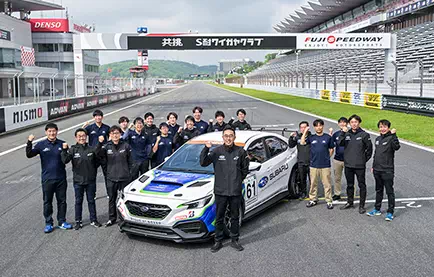
Establishment and Initiatives of the Research Association of Biomass Innovation for Next Generation Automobile Fuels
SUBARU, together with ENEOS, Suzuki, Daihatsu Motor, Toyota Motor and Toyota Tsusho, established the Research Association of Biomass Innovation for Next Generation Automobile Fuels to improve efficiency in the fuel production process. Currently, seven companies, including Mazda, are participating in this association to advance technological research for the efficient production of bioethanol fuel for automobiles in order to realize a carbon-neutral society.
Providing Vehicles Using Synthetic Fuel at Expo 2025 Osaka, Kansai, Japan
SUBARU provided vehicles for officials at the Expo 2025 Osaka, Kansai, Japan, using synthetic fuel produced by ENEOS. Synthetic fuels are clean liquid fuels made from hydrogen derived from renewable energy sources and CO2, and are expected to help reduce CO2 emissions from internal combustion engines while utilizing existing infrastructure.
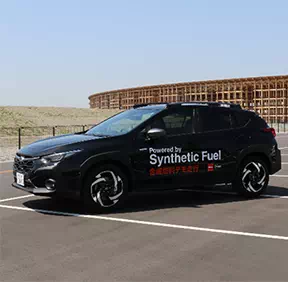
Conducted a Helicopter Test Flight Using Sustainable Aviation Fuel (SAF)*3
In March 2024, SUBARU successfully conducted a test flight using SAF in a Group-owned helicopter. As an aircraft manufacturer, Subaru will continue to develop decarbonization technologies to contribute to the realization of a sustainable society.
- *3
- Sustainable aviation fuel is produced from resources such as plants and waste cooking oil. Plants, which are the main raw material, absorb carbon dioxide from the atmosphere during photosynthesis, thus achieving a balance between absorption and emission, offering reduction in greenhouse gas emissions compared to conventional fossil fuel-based aviation fuels. In addition, the reuse of used oils such as waste cooking oil leads to reduced waste and effective utilization of resources, and is expected to further reduce environmental impact
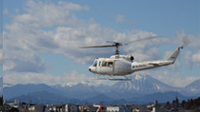
Site Initiatives
Toward the medium-term goals for FYE March 2036, the SUBARU Group will implement energy-saving measures along with other initiatives, such as in-house generation or purchase of carbon-neutral electric power and introduction of hydrogen, ammonia, and other carbon-neutral fuels, as part of systematic Scope 1 and 2 emissions reduction.
FYE March 2025 Reduction Measures and Impact (Compared with FYE March 2017)
| Measure | CO2 reduction impact (t-CO2) |
|---|---|
| Energy conservation through facility upgrades | 6,212 |
| Generation of renewable energy (solar power generation) | 5,213* |
| Purchase of carbon-neutral electricity | 84,902* |
| Use of Green Power and Green Heat Certificates | 5,262 |
| Total | 101,589 |
- *
- CO2 emission reductions are calculated by multiplying the amount of electricity use derived from renewable energy sources by the CO2 emission coefficient of TEPCO Energy Partner, Inc.’s residual rate options for the relevant fiscal year
Topics Introduction of an Off-Site Corporate PPA
SUBARU has concluded a three-party off-site PPA* with TEPCO Energy Partner, Inc. and Fuji Technical Co., Ltd.
Through this project, starting in February 2025, TEPCO Energy Partner has supplied SUBARU’s Tokyo Office and others with electricity generated at Fuji Technical’s solar power plant. Furthermore, an agreement will be concluded whereby renewable electricity generated by power generation facilities installed based on existing agreements and newly constructed solar power plants will be supplied by TEPCO Energy Partner to SUBARU’s Yajima Plant and Tokyo Office from February 2026 onward.
By further expanding the use of renewable electricity through this initiative, it is expected that approximately 10% of the electricity used at the Yajima Plant and 14% at the Tokyo Office will be switched to carbon neutral electricity.
- *
- Off-site corporate power purchase agreement (PPA): a long-term contract for renewable electricity generated at the facilities of a power producer to be supplied to a consumer via a retail electricity provider
Energy Conservation Through Facility Upgrades
To reduce greenhouse gas emissions and improve energy efficiency, the SUBARU Group is promoting measures such as the introduction of cogeneration facilities and high-efficiency equipment, the use of heat-shielding and heat-insulating building materials, and the introduction of energy management systems to improve production equipment efficiency.
List of energy conservation initiatives through facility upgrades
| Measure | Site/Group company | Main initiatives |
|---|---|---|
| Improving the efficiency of production equipment | Gunma Plant |
|
| Utsunomiya Plant |
|
|
| Tokyo Office | LED lighting in the entire facility and insulated glass and building materials | |
| Fuji Machinery Co., Ltd. | Switching from kerosene to electricity for heating energy | |
| Subaru of Indiana Automotive, Inc. | Installing air conditioning control valves, LED lighting in the entire facility, introducing motion sensors |
- *
- Nearly ZEB is a building that achieves at least a 75% reduction in primary energy consumption compared to a reference building and is very close to achieving Net Zero Energy Building certification

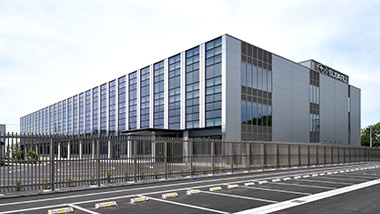
The Main Administration Building
Use of Renewable Energy (Solar Power Generation)
The SUBARU Group is proactively promoting the installation of solar power generation facilities. At our various facilities, including the Gunma Plant, Tokyo Office, and Utsunomiya Plant, we have achieved significant reductions in CO2 emissions by incorporating equipment plans into new buildings from the design stage and installing equipment on the roofs of existing buildings. In addition, we are promoting measures such as selling solar power generated on idle land and at other property, as well as the conversion of energy from kerosene to electricity, steadily expanding the scope of utilizing renewable energy.
As of FYE March 2025, the SUBARU Group has installed approximately 11 MW of solar power generation facilities, and approximately 12,000 MWh of the electricity generated from these facilities is used in-house.

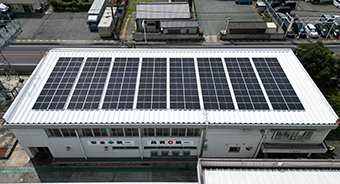

Purchase of carbon-neutral electricity
The SUBARU Group is actively working to purchase carbon-neutral electricity. All of the electricity purchased at the six SUBARU facilities of Gunma Main Plant, Utsunomiya South Plant and 2nd South Plant, the Handa West Plant (including Yusoki Kogyo K.K.), the Isesaki Plant, and the Ebisu Subaru Building, and at the two Group companies in Japan of Subaru Finance Co.,Ltd. and Kiryu Kogyo Co., Ltd. is carbon-neutral electric power.
At the Utsunomiya Plant, we have introduced the Tochigi Furusato Denki program*, which utilizes hydroelectric power generated by Tochigi Prefecture, and at the Gunma Plant, we plan to supply hydroelectric power via a local production for local consumption PPA (Gunma Model) from FYE March 2026, among other efforts to both reduce environmental impact and contribute to local communities.
- *
- Electricity service program co-hosted by the Tochigi Public Enterprise Bureau and TEPCO Energy Partner, Inc. Supplies electricity generated by eight hydroelectric power stations run by the Tochigi prefectural government. Hydropower users can claim to be emitting no CO2 from using the electricity, on the grounds of its CO2-free generation process
Use of Green Power and Green Heat Certificates
The SUBARU Group is reducing CO2 emissions by utilizing green power certificates and other green power and heat certificates at its manufacturing plants and related facilities throughout Japan. In FYE March 2025, the Group purchased certificates equivalent to 12,000 MWh of electric power, equivalent to 5,262 t-CO2 of emissions, through Japan’s Green Power Certification System.
Sales Initiatives
Dealerships in Japan
As awareness of the environment grows, dealerships in Japan are working toward carbon neutrality by converting to CO2-free electricity (carbon-neutral power plans). As of FYE March 2025, approximately 60% of electric power consumption has been converted to CO2-free electricity. At present, a total of 16 dealerships, including non-consolidated dealerships, have completed their conversion. We aim to complete conversion at all consolidated dealerships*1 by the end of FYE March 2026.
- *1
- Excluding some facilities where conversion is physically difficult due to tenant use or restrictions on available power plans

Subaru of America, Inc.
Subaru of America, Inc.’s headquarters and National Service Training Center have acquired silver LEED certification,*2 which is higher than standard certification. In 2021, the company enhanced energy efficiency by installing automated equipment and comprehensive air conditioning systems at its headquarters building and National Service Training Center.
In addition, at the headquarters building, the company utilizes 100% renewable energy and has upgraded to LED lighting. In 2021, the headquarters lobby was designed to efficiently incorporate natural light, thereby reducing the electricity consumption for lighting.
- *2
- Leadership in Energy and Environmental Design (LEED) certification is a green building certification system developed and operated by the U.S. Green Building Council (USGBC). It provides objective environmental performance data on buildings through evaluation of energy conservation and environmental impact reduction abilities for a range of project stages from overall planning and design to construction, management, and maintenance. Acquisition of the certification is becoming popular in the U.S. and in other countries
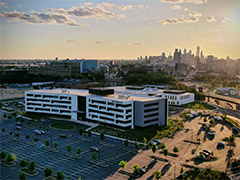

Subaru Canada, Inc.
The building that houses Scott Subaru, a retailer in Canada, is designed for high energy efficiency, which includes eliminating the need for heating and cooling facilities. It has received certification as a “passive house,” or energy-efficient building.
Logistics Initiatives
SUBARU is collaborating across the entire Group, including with logistics companies, dealerships, as well as with other automotive industry players to reduce CO2 emissions in logistics operations by an annual 1% through increased transport efficiency for finished vehicles and export parts.
In addition, we are working to strengthen governance aimed at reducing environmental impact in the logistics field through the activities of the Logistics Environment Subcommittee, which coordinates all logistics-related departments within SUBARU. SUBARU believes that strengthening its supply chain will lead to achieving carbon neutrality by 2050, and we will continue efforts to increase the accuracy of CO2 emissions calculations and expanding their calculation scope, in addition to our reduction activities.
SUBARU’s logistics system
Transport of Finished Vehicles
SUBARU is establishing optimal standard routes for finished vehicles, flexibly accommodating shipping of a wide range of vehicle types and sizes (particularly large cars), improving loading efficiency, and promoting modal shift.*1 We also request that our logistics partners help to minimize the environmental impact of their finished vehicle transport operations, taking actions such as practicing eco-conscious driving by installing digital tachographs*2 and dash cams, as well as improving fuel efficiency by fitting aerodynamic panels and other devices.
Per unit CO2 emissions from transportation of vehicles in FYE March 2025 declined 26.07% from the FYE March 2007 level, against the target of a 18% reduction from the base year. We will continue with our efforts to pursue further reductions.
- *1
- For cargo transportation, switching transportation modes from trucks to those imposing less environmental burden, such as railway and seaborne systems
- *2
- Fitted to a vehicle as a tool for driving management in commercial vehicle operation to automatically record its journey information, including driving time and speed, and store the information in the installed recording medium, such as a memory card. As the system can present clear data of recorded events, including sudden acceleration and deceleration, fuel-wasting engine idling, and dangerous driving, it is expected to help drivers increase their awareness of safe driving and fuel economy
Export Parts
In the transport of parts for overseas production, we are making ongoing efforts to improve the container fill rate through measures such as utilizing unused upper space in high cube containers, improving packing modes, and employing lighter-weight packaging materials. As a result, we achieved a fill rate of 98% in FYE March 2025. We will continue to actively work toward reducing CO2 emissions through other initiatives such as round use*3 to streamline container transportation, utilization of inland container depots*4, and the reuse of import containers used by other companies in the Gunma area.
- *3
- Using import containers for export instead of returning them empty to port, thereby reducing the transport of empty containers from ports
- *4
- Depot located inland for consolidation of container cargo
Parts and Accessories
- Joint distribution initiative with Toyota Mobility Parts Co., Ltd.
To resolve complexities and inefficiencies in parts of our transport system, we began joint distribution of maintenance parts with Toyota Mobility Parts Co., Ltd. in FYE March 2021. As of the end of FYE March 2025, we had started joint distribution to nine dealerships (27 retail locations and external business partners in various regions). We aim to work toward joint distribution in other regions going forward.
By switching to joint distribution, we have in the case of some dealerships achieved a reduction of lead time by one day and a cut in transport costs of approximately 25%. - Switch to forklift trucks with electric drive option
The Accessory Center in Gunma is making a phased switch when replacing liquefied petroleum gas (LPG)-operated forklift trucks to models that can be operated electrically (two units in FYE March 2025). In FYE March 2026, as part of our forklift reduction activities, we will utilize hour meters to reduce the number of low-utilization forklifts and improve overall utilization rates.
Subaru of America, Inc.
The company is promoting the use of rail to reduce CO2 emissions in the distribution process. We are also working to reduce emissions from marine transportation to dealerships in Alaska through the use of LNG. These efforts have resulted in a 25% reduction in CO2, a 95% reduction in NOx, and a 100% reduction in SOx. In addition, the use of LNG vessels has reduced greenhouse gas emissions by up to 21%.
Procurement Initiatives
We have set out a code of conduct that requires supplier selection and management mechanisms relating to climate change issues, and share the code with our suppliers, asking them to take appropriate actions when providing orientation sessions. By encouraging business partners to obtain ISO 14001 certification, we are working to prevent environmental accidents and mismanagement events in the supply chain and reduce the risk of infringement of environmental laws and regulations.
In addition, we request that business partners cooperate in decarbonization during our procurement policy briefings. In FYE March 2025, we shared our reduction targets with our business partners and asked for their cooperation. As a new initiative, we have requested that each company submit a roadmap and are identifying specific initiatives and issues through interviews.
For business partners near the Gunma Plant, a major plant receiving supplier materials at the SUBARU Group, we also assessed the risk of water-related disasters at more than 1,200 sites, including Tier 2 sites. In addition to sharing the results of these risk assessments with business partners, we work with them on initiatives such as checking contingency actions using a sheet for checking BCP initiative status as well as conducting mock drills and confirming subsequent corrective measures.
Other Climate Change Initiatives
Carbon Pricing
Emissions Trading Systems
As businesses operating in the jurisdictions of the Tokyo metropolitan and Saitama prefectural governments, our Tokyo Office, Kitamoto Plant, and Stellar Town Omiya are covered by the Tokyo Metropolitan Environmental Security Ordinance, which promotes greenhouse gas reduction and emissions trading for large businesses, and the Saitama Prefecture regulation on target-based emissions trading. Our business sites are responding through compliance with the relevant emissions trading systems.
In addition, SUBARU has endorsed the GX League Basic Concept announced by Japan’s Ministry of Economy, Trade and Industry, and has joined the GX League as of 2024.
Internal Carbon Pricing
SUBARU introduced internal carbon pricing in FYE March 2023. In the internal consultative plan on capital expenditures at business sites, the monetary value of the CO2 reduction accompanying the introduction of the relevant facilities is set at 6,000 yen/t-CO2. By accounting for CO2 reduction impact in terms of its cost reduction impact, we ensure its inclusion as a factor in assessing capital expenditures. The introduction of internal carbon pricing, which comes under the category of shadow pricing, is intended not only to raise awareness of CO2 reduction among facility managers but also to promote investment in facilities with a high CO2 reduction impact.

